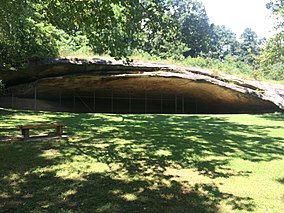Graham Cave State Park
State park in Missouri, United States From Wikipedia, the free encyclopedia
State park in Missouri, United States From Wikipedia, the free encyclopedia
Graham Cave State Park is a state park in the U.S. state of Missouri consisting of 369 acres (149 ha) located in Montgomery County. The park's namesake, Graham Cave, is a cave in St. Peter sandstone with an entrance 120 feet (37 m) wide and 60 feet (18 m) high and an extent of about 100 feet (30 m) into the hillside. The cave protects an historically important Pre-Columbian archaeological site dating back to as early as 10,000 years ago.[5] Visitors are allowed up to the entrance of the cave where interpretive signs point out significant discoveries. The park includes the 82-acre (33 ha) Graham Cave Glades Natural Area which protects an area of sandstone and dolomite glades with a rich diversity of glade species.[6] The park is adjacent to Interstate 70 from which the entrance to the cave can be glimpsed during foliage-free months.[7]
| Graham Cave State Park | |
|---|---|
 The cave entrance | |
| Location | Montgomery County, Missouri, United States |
| Coordinates | 38°54′24″N 91°34′38″W[1] |
| Area | 386.13 acres (156.26 ha)[2] |
| Elevation | 725 ft (221 m)[1] |
| Established | 1964[3] |
| Visitors | 78,425 (in 2022)[4] |
| Governing body | Missouri Department of Natural Resources |
| Website | Graham Cave State Park |
In 1847, settler Robert Graham purchased the property containing the cave, and the land remained in the Graham family until it was donated to the state for a state park in 1964 by Frances Graham Darnell, Robert's great-granddaughter. Robert Graham's son, D. F. Graham, sheltered hogs in the cave and became interested in archeology from the artifacts he found there. His collection of artifacts was offered by his son Benjamin to the University of Missouri, which investigated the cave in 1930. Benjamin's son-in-law, Wade Darnell, was persuaded to delay plans to enlarge the shelter for his livestock in 1948 so that archeological excavations could be made. The University of Missouri and the Missouri Archaeological Society excavated the cave between 1949 and 1961. The importance of the findings in that period resulted in the site being the first archaeological site in the United States to be designated a National Historical Landmark in 1961. Frances Graham Darnell donated the cave and surrounding land to the state of Missouri in 1964 to be a state park.[8]
Artifacts recovered from the cave indicate that the cave's inhabitants used spears to hunt and fish. A ring of smaller stones surrounding a larger stone was found in the cave, suggesting that ceremonies were held. Pottery shows that more recent Native Americans also lived in the cave.[9]
The state park offers access to the Loutre River for boating and fishing, hiking trails named Fern Ridge (0.3 miles (0.48 km)), Loutre River (2.2 miles (3.5 km)), and Indian Glade (0.9 miles (1.4 km)), and camping facilities.[7]
Seamless Wikipedia browsing. On steroids.
Every time you click a link to Wikipedia, Wiktionary or Wikiquote in your browser's search results, it will show the modern Wikiwand interface.
Wikiwand extension is a five stars, simple, with minimum permission required to keep your browsing private, safe and transparent.